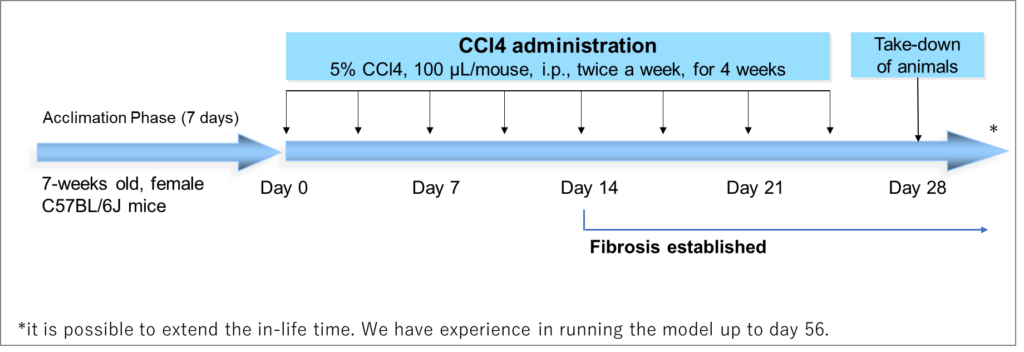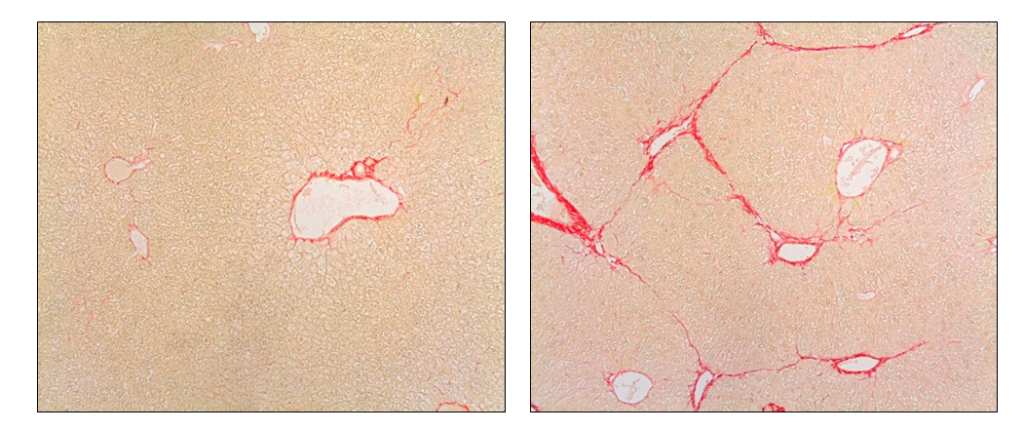MODEL LINEUP
CCl4-induced liver fibrosis model
The CCl4-induced liver fibrosis model
The CCl4-induced liver fibrosis model (carbon tetrachloride) is a rapid, cost-effective rodent paradigm in which twice-weekly CCl₄ injections trigger hepatocyte injury, necrosis and inflammation. It leads to significant collagen deposition and bridging fibrosis within four weeks (cirrhosis by eight weeks). It recapitulates key features of human disease such as stellate cell activation (α-SMA expression), extracellular matrix accumulation, regenerative nodules and elevated AST/ALT. This highly reproducible model is ideal for studying acute liver injury, advanced fibrosis and reversal mechanisms, as well as for preclinical screening of anti-fibrotic therapeutics using quantifiable endpoints such as Sirius Red staining and assessment of the liver hydroxyproline content.
If you are interested in a liver fibrosis model that shows milder and chicken-wire type fibrosis or a model that is based on MASH and type 2 diabetes, please also have a look at our “STAM™ model” for more details.
Benefits of using the CCl4-induced liver fibrosis model
The CCl4-induced liver fibrosis model is one of the most widely used animal models to evaluate the pharmacological efficacy of drug candidates against advanced liver fibrosis / cirrhosis.
| Rapid fibrosis induction: | Hepatocyte damage, necrosis, and inflammation occur within four weeks, progressing to cirrhosis by eight weeks. |
| Highly reproducible: | This model consistently produces fibrosis, making it ideal for drug screening and therapeutic evaluation. |
| Mimics human disease: | It closely resembles human liver fibrosis, including stellate cell activation, extracellular matrix accumulation, and regenerative nodules. |
| Versatile applications: | It is commonly used to study acute liver injury, advanced fibrosis, and fibrosis reversal, providing insights into disease progression and treatment strategies. |
How we create the CCl4-induced liver fibrosis model

Fig.: Creation of the CCl4 model and disease time line
The established and well-tested model that we are using at SMC Laboratories is based on 7 weeks-old, female C57BL/6J mice. To create the CCL4-induced liver fibrosis model, we administer carbon tetrachloride (CCL4) through intraperitoneal injections twice per week for at least 4 weeks to induce inflammation and advanced liver fibrosis.
It is also possible to extend the induction period to increase the severity of the liver fibrosis, which makes the model suitable to study and evaluate drug compounds targeted at cirrhosis.
Analysis items and key endpoints
| Histopathological analysis |
| Sirius Red staining |
| Immunohistological staining (IHC) |
| Collagen Type 1
Collagen Type 3 α-SMA etc. |
| Biochemistry analysis |
| ALT / AST
Liver hydroxyproline content etc. |
| Gene expression analysis |
| Collagen Type 1
Collagen Type 3 α-SMA TNF-α TIMP-1 etc. |
The above-mentioned analysis items, are routinely performed in our standard study package, however, we have the ability to perform a number of additional analysis assays that are available upon request and can be included in your preclinical drug evaluation study.

Fig. 2: Sirius Red stained samples of normal mouse liver (left) vs. CCl4-induced liver fibrosis model (right) with a magnification of 100x.
Available Positive Controls
Due to our many years of experience, we have established a number of different positive control drugs such as Semaglutide, Valsartan and Telmisartan. These drugs showed improving effects on the key parameters in the CCl4-induced liver fibrosis model and can be used as reference for estimating the efficacy of your drug candidate.
Contact us
If you have any questions regarding our CCl4 model or would like to discuss which liver fibrosis model would be the best fit to evaluate your drug compound, please feel encouraged to reach out to us.
We are experts in the field of liver diseases with many years of consulting experience and would be happy to support you with your preclinical drug development.
